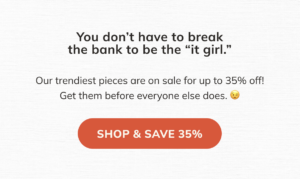Samantha Lo
Research has shown that marketing techniques that employ FOMO yield a higher response rate, with a survey conducted by Expedia finding that 67 per cent of their travellers booked a trip due to FOMO.
A study conducted by Hubspot also found that using FOMO marketing tactics can increase email open rates by 22 per cent. When customers are contemplating a purchase, a sneaky reminder is often enough to get them to click that pay button.
Why is this seemingly ordinary phenomenon more dangerous than it appears?
The Psychology Behind FOMO Marketing
This year, The Improv Comedy Club launched a marketing campaign that exemplifies the essence of FOMO marketing. In the video, a confused office clerk watches his colleagues laugh hysterically as they discuss “last night’s comedy show” without being privy to the joke. The advertisement closes with the punchy and regretful tagline: “Shoulda been there.”
“Capitalising on the universal feeling of FOMO drives consumer engagement”
As shown in this campaign, marketers package their products — whether a physical item or a ticket to an experience — as gateways to social inclusion, exploiting individuals’ deep-seated fear of exclusion.
Psychology has long connected FOMO with concepts of self-esteem and social status. Researchers suggest that FOMO is “closely connected to individuals’ self-perception and approaches to appraising their relationships with others.” FOMO marketing does not encourage consumers to think about what they want, but rather compels them to think about the negative consequences of missing out on a certain product.
What Does FOMO Marketing Look Like?
Exploiting customers’ yearning for social approval is also a powerful psychological tool used by marketers to enhance sales in the retail industry.
This promotional email sent by a jewellery brand portrays their products as having the magical ability to transform the consumer into an “it girl.” The upgrade of style is presented as a competition, one that you’d be falling behind in if everyone else gets it before you do.

Even for sellers of essential products, FOMO marketing techniques persist. Take, for instance, this promotional email for contact lenses:

It asks the recipient: “Did you miss our Cyber Monday SALE,” implying that they should have purchased because of the sale, as opposed to because they genuinely needed something. It is likely that the brand never intended for the sale to conclude on Cyber Monday in the first place.
The TikTok Effect
In 2023 we saw an expected increase in the use of videos and live-streaming in marketing.
This was especially prevalent on TikTok, which had 1.5 billion monthly active users this year and is expected to reach 2 billion by the end of 2024. Influencer collaborations with brands are a classic FOMO marketing technique, often employing phrases such as “run don’t walk to *insert store name*” and “you need this *insert item* in your winter wardrobe!”
Needless to say, leveraging social media icons as brand advocates is a foolproof way to boost sales where capitalising on the universal feeling of FOMO drives consumer engagement.
FOMO’s Partner in Crime: Urgency Marketing
However, FOMO marketing occasionally appears more subtly than the blatant “you are missing out” narrative.
Websites will often offer gentle reminders of how many people are viewing the product, how many have added it to their carts, or how many items were sold daily, reminding customers that everyone else is already getting their hands on it. Countdown timers also instil a sense of urgency to joining a trend, telling customers that they are letting the opportunity slip by with each tick of the clock.
The combination of such techniques makes visiting an online shopping site such an urgent experience that it becomes difficult for individuals to resist the impulse to make a purchase.
Why is FOMO Marketing Harmful?
There are already an abundance of online guides authored by marketing professionals teaching business owners how to effectively employ FOMO to both attract and retain customers. To make matters worse, there is an absence of articles warning consumers of the dangers of these marketing techniques.
https://twitter.com/dentos_wife/status/1743308778798227802
The internet seems to have brushed over the ethical implications of exploiting people’s insecurities for commercial gains. Overpurchasing both risks detrimental impacts on individuals’ finances, and undermines the sustainability efforts that many are working hard to promote.
How To Combat FOMO Marketing
FOMO marketing will likely remain an effective marketing technique for as long as social media exists. However, being aware of it is the first step in combating it. These techniques only work when we are cognizant of the true intention behind FOMO marketing: spending money.
Some simple ways to evade the temptations of FOMO marketing include: making a wish list and strictly adhering to it to avoid impulse purchases, shopping in-store as opposed to online to reduce exposure to the manipulation tactics on social media, and allowing yourself a cool-down period between adding items to the cart and paying for them.
FOMO is constantly tricking us into thinking the grass is always greener. However, when it comes to purchasing, being intentional with your buys and cultivating gratitude for what you already own will often reveal that you’re not missing out on anything.
READ NEXT:
-
WHY DON’T WE TAKE WOMEN’S CHRONIC PAIN SERIOUSLY?
-
REDIRECTING MEDIA NARRATIVES OF MENTAL HEALTH DISORDERS
-
THE ETHICS OF TOURISM IN HAWAII
Featured image courtesy of Campaign Creators via Unsplash. No changes were made to this image. See image license here.

![Image shows a piece of paper on a desk with the words 'marketing strategy' printed onto it [FOMO marketing]](https://www.empowordjournalism.com/wp-content/uploads/2024/01/campaign-creators-yktK2qaiVHI-unsplash-scaled-e1704723030739-1035x425.jpg)